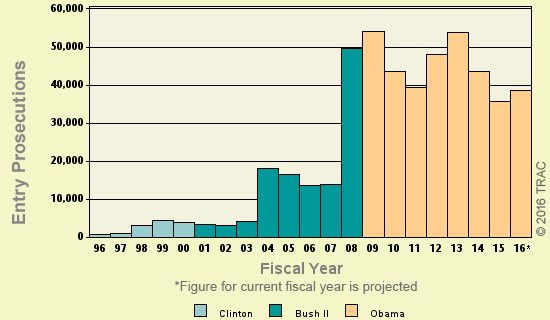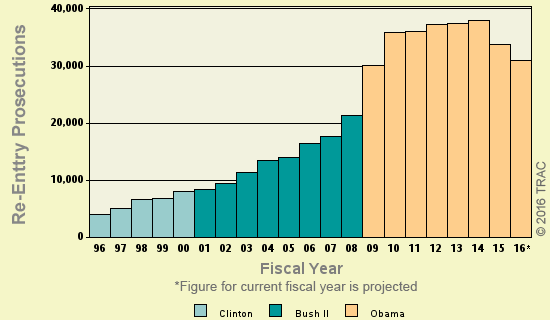Criminal Prosecutions for Illegal Entry Up, Re-Entry Down
Latest Figures as of May 2016
| Illegal Entry | Illegal Re-Entry | |
|---|---|---|
| Number Fiscal Year-to-date | 25,680 | 20,628 |
| Percent Change from previous year | 7.7% | -8.4% |
| Percent Change from 5 years ago | -2.1% | -14.4% |
| Percent Change from 10 years ago | 182% | 87.6% |
| Percent Change from 20 years ago | 6407% | 668% |
The latest available data from the Justice Department show that during the first eight months of FY 2016 the government reported 25,680 new criminal prosecutions for illegal entry, and 20,628 new criminal prosecutions for illegal re-entry. Illegal re-entry charges under Title 8 Section 1326 of the United States Code are a felony, while illegal entry prosecutions under Title 8 Section 1325 are only a petty misdemeanor. These comparisons of the number of defendants charged with offenses are based on case-by-case information obtained by the Transactional Records Access Clearinghouse (TRAC) at Syracuse University under the Freedom of Information Act from the Executive Office for United States Attorneys (see Table 1).
Trends Differ by Lead Charge
Illegal Entry. If the pace of criminal prosecutions during the first eight months of FY 2016 continue at the same rate, the annual number of prosecutions for illegal entry will total 38,520 for this fiscal year. According to the case-by-case information analyzed by TRAC, this estimate is up 7.7 percent over the past fiscal year when the number of illegal entry prosecutions totaled 35,770.
The lead investigative agency for prosecutions through May 2016 was Customs and Border Protection (CBP) in the Department of Homeland Security. CBP which includes the Border Patrol accounted for 97.9 percent of prosecutions referred. Immigration and Customs Enforcement (ICE), also in Homeland Security, accounted for most of the remaining percentage.
Illegal Re-Entry. In contrast, the pace of prosecutions this year for illegal re-entry is down. For these more serious felony prosecutions, TRAC estimates their number will total 30,942 for this fiscal year, assuming the same pace continues for the rest of FY 2016. This would represent an 8.4 percent decline from the past fiscal year when the number of illegal re-entry prosecutions totaled 33,795.
CBP (including the Border Patrol) was the lead investigative agency for 79.2 percent of illegal re-entry prosecutions referred. ICE was the lead investigative agency for 16.3 percent, while the U.S. Citizen and Immigration Services (USCIS) in Homeland Security accounted for 3.8 percent.
Long Term Trends. The long term trend in prosecutions for these matters going back to FY 1996 is shown more clearly in Figures 1 and 2. The vertical bars in each time series graph represent the number of prosecutions of this type recorded each fiscal year. Projected figures for the current fiscal year are shown. Each presidential administration is distinguished by the color of the bars.

Figure 1. Criminal Illegal Entry Immigration Prosecutions Over the Past Twenty Years

Figure 2. Criminal Illegal Re-Entry Immigration Prosecutions Over the Past Twenty Years
Top Ranked Judicial Districts Differ by Charge
Prosecutions are concentrated in the five federal judicial districts along the nation's southwest border with Mexico. However, as we previously reported here and here, individual districts differ greatly in their charging and plea bargaining patterns.
For the first eight months of the current fiscal year, the Southern District of Texas (Houston) and the Western District of Texas (San Antonio) accounted for 96 percent of the country's total of 25,680 illegal entry prosecutions. Arizona and New Mexico together accounted for less than 3 percent of this total.
In contrast, during the same period illegal re-entry prosecutions were concentrated in Arizona and New Mexico. These two districts accounted for 59 percent of the country's total of 20,628 illegal re-entry prosecutions during the first eight months of fiscal year 2016. The Southern and Western Districts of Texas were far behind with only 25 percent between them.
The Southern District of California (San Diego) among the five border districts ranked last in both illegal entry as well as illegal re-entry prosecutions. Although illegal re-entry was the more common charge also in that district.
Tables 2 and 3 below provide for illegal entry and for illegal re-entry, respectively, the figures for the top ten districts in their rates of criminal prosecution thus far during FY 2016.
|
Table 2. Top 10 Districts for Illegal Entry Prosecutions
per one million people
|
Table 3. Top 10 Districts for Re-Entry Prosecutions
per one million people
|